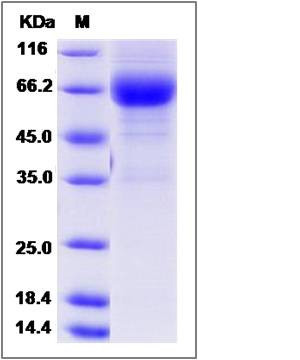Rat LTBR / TNFRSF3 Protein (Fc Tag)
LTBR
- 100ug (NPP3084) Please inquiry
| Catalog Number | P80178-R02H |
|---|---|
| Organism Species | Rat |
| Host | Human Cells |
| Synonyms | LTBR |
| Molecular Weight | The recombinant rat LTBR/Fc is a disulfide-linked homodimer. The reduced monomer comprises 432 amino acids and has a predicted molecular mass of 48.5 kDa. The apparent molecular mass of the protein is approximately 66 kDa in SDS-PAGE under reducing conditions. |
| predicted N | Ser 28 |
| SDS-PAGE |  |
| Purity | (9.8+79.7) % as determined by SDS-PAGE |
| Protein Construction | A DNA sequence encoding the rat LTBR (Q5U2S8) (Met1-Ala218) was expressed with the Fc region of human IgG1 at the C-terminus. |
| Bio-activity | |
| Research Area | Immunology |Inflammation / Inflammatory Mediator |Inflammatory Cytokines & Chemoki and Receptors |TNF Superfamily |Processes Regulated by TNF Superfamily Members |Other Cell Type-specific Responses Regulated by TNF Superfamily Members | |
| Formulation | Lyophilized from sterile PBS, pH 7.4. 1. Normally 5 % - 8 % trehalose and mannitol are added as protectants before lyophilization. Specific concentrations are included in the hardcopy of COA. |
| Background | LTBR (lymphotoxin beta receptor (TNFR superfamily, member 3)) is a member of the tumor necrosis factor (TNF) family of receptors. Tumor necrosis factor receptor is a trimeric cytokine receptor that binds tumor necrosis factors. The receptor cooperates with an adaptor protein (such as TRADD, TRAF, RIP), which is important in determining the outcome of the response. LTBR is expressed on the surface of most cell types, including cells of epithelial and myeloid lineages, but not on T and B lymphocytes. LTBR specifically binds the lymphotoxin membrane form (a complex of lymphotoxin-alpha and lymphtoxin-beta). LTBR and its ligand play a role in the development and organization of lymphoid tissue and tranformed cells. Activation of this protein can trigger apoptosis. Not only does the LTBR help trigger apoptosis, it can lead to the release of the cytokine interleukin 8. Overexpression of LTBR in HEK293 cells increases IL-8 promoter activity and leads to IL-8 release. It is also essential for development and organization of the secondary lymphoid organs and chemokine release. |
| Reference |
